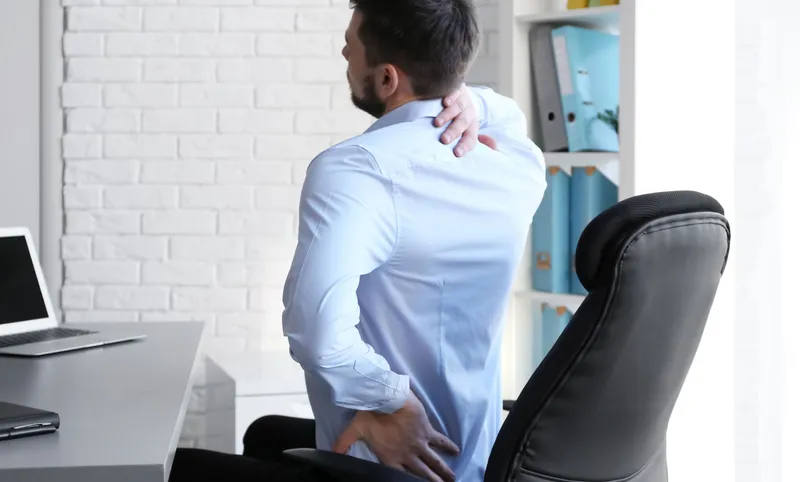How bad posture can harm our health
Multiple research links poor structure, bad posture, and constricted nerves with several symptoms and conditions. Most people with neck problems such as cervical spondylitis or whiplash later develop hypothyroidism or dizziness.
In functional medicine, there is a fascinating connection between the structure or posture of your body with possible symptoms and conditions. The spinal cord carries the nervous system, and the main nerve, known as the vagus nerve, is involved in several key functions of the body.
Multiple research links poor structure, bad posture, and constricted nerves with several symptoms and conditions. Over two decades, a common thing that I noticed was those with neck problems such as cervical spondylitis or whiplash later developing hypothyroidism or dizziness. This is a common connection, but one that is often overlooked in mainstream medicine.
This is just one of those connections, but going through some of these interlinks between structure, posture, and symptoms can be a great place to begin your health journey.
Structural aspects that can trigger symptoms and conditions
Body aches, joint pain, neck pain, poor posture, slouched upper back, sitting all day, neck discomfort, back pain, loss of muscles, bearing weight on one foot, bearing weight on the outer side of the feet, and lack of support for the arms while working can all be potentially problematic.
Do you find yourself slouching and feeling stress in the upper back and shoulders? Does your job make you sit at your desk all day long? Do you always have tension in your neck and shoulders? Do you put all the weight of your body onto the outer parts of both feet and struggle with pain in the back? Any of this is interlinked with the other.
If you stress the muscles in a certain area of the body, invariably you will end up constricting nerves around them, impacting systems and organs which the same nerves regulate. Constriction of muscles also causes poor blood supply to these systems and organs. Now, what are these connections?
Interconnections of body areas and symptoms
This is not a complete list of connections between constricted areas, poor posture, and symptoms. But it will give an overarching view as to how these connections are.
1. In the cervical region around your neck, there are branches of nerves which control the intracranial blood vessels, eyes, head, neck, muscles, diaphragm, shoulders, elbows, arms, wrists, hands, fingers, esophagus, heart, lungs, and chest.
A poor posture or injury in the neck can cause symptoms that include headaches, migraines, dizziness, sinusitis, allergies, frequent colds, chronic fatigues, high blood pressure, heart conditions, numbness in the fingers, pain in the arms, vision problems, sore throat, hypothyroidism, asthma, and vertigo. Many of these symptoms can originate because of a bad neck injury or poor posture at the neck.
Make sure you have your desk at the right level, where you rest your arms and avoid stressing the neck. If you have specific neck injury, work with an experienced yoga therapist to restore mobility and circulation in the neck.
2. In the thoracic area of the spine, which is the surrounding muscles around the upper and mid spine, the nerves in the upper back control the arms, esophagus, heart, lungs, chest, larynx, and trachea. Nerves in the middle back control the gallbladder, liver, diaphragm, stomach, pancreas, spleen, kidneys, small intestine, appendix, adrenal glands, colon, uterus, and buttocks.
Poor posture in the upper back and middle back, which comes from hunching and sitting all day, can cause several symptoms. This constriction of nerves can also come from tight pectoral muscles of the chest and weak trapezoid muscles, which is the triangular muscle of the upper back. Those who practice shoulder stand for too long without balancing it with a fish pose for as long, can naturally end up this way.

Symptoms and conditions from poor posture of the upper and mid back include numbness, pain, back pain, congestion in the lungs, shallow breathing, asthma, high blood pressure, heart disease, bronchitis, pneumonia, gallstones, jaundice, fatty liver, digestive distress, stomach problems, ulcers, heartburn, gastritis, urinary problems, and kidney issues. Observe if you tend to slouch and appear as a hunchback. Try to work with a trainer to stretch the pectorals and strengthen the trapezoid to naturally open the chest.
3. The lumbar spine, which is the lower part of the spine where commonly there are challenges with slip disc, regulate nerves to the large intestine, buttocks, groin, reproductive organs, colon, thighs, knees, legs, and feet. If you have experienced a slip disc, your body might try to protect the area by tensing some muscles in the area around these vertebrae. Any tension in the back, which can also be due to tight hips, can cause symptoms.
If you are unable to sit on the floor cross legged without your back tilting forward due to the tightness in the hips, you would end up contributing to problems that include constipation, colitis, diarrhea, gas, bloating, irritable bowel syndrome, urinary infections, irritable bladder, menstrual problems, PMS, low back pain, and numbness in the legs. You would need to ensure that you elevate the hip a little, while sitting on a chair, and work with a yoga therapist to loosen the hips and backs. These gentle interventions are indeed powerful in resolving symptoms associated with tense lower back and hips.
4. The sacral area of your spine, which is the bottom of the tailbone, controls the areas of the buttocks, reproductive organs, bladder, prostate, legs, ankles, feet, and toes. It is linked with the lumbar region, and constriction of nerves and poor posture can cause constipation, diarrhea, bladder irritation, menstrual problems, lower back pain and numbness in the legs.
Posture your way to good health!
You might have a great diet and wonder why you still struggle with symptoms. Well, the answer might very well lie in these connections between the structure of your body, posture, and symptoms that are associated with nerves surrounding the areas. Having a skilled practitioner can help you structure your body to balance and posture your way to better health!
Edited by Megha Reddy
(Disclaimer: The views and opinions expressed in this article are those of the author and do not necessarily reflect the views of YourStory.)







